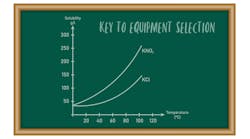Roll presses generate extremely high pressures that agglomerate granular particles into a sheet or individual briquettes. Although the roll press must be strong enough to withstand these high pressures, it is the press feed system that determines if and how well the press will operate at the required pressures because the press itself amplifies pressures created by the feed system.
FIVE COMMON FEED SYSTEMS
Single Screw Feed System
The advantage of a single screw feeder is its simplicity. The flood-loaded screw controls the press feed rate through the screws rpm. Adding a scraper bars aids the flow of cohesive materials.
Because a screw feeder can generate large pressures at the interface between the screw and press, it requires a smaller roll diameter than a gravity feed press. As a result, the discharge end screw flights are usually constructed using a thicker and harder material to account for high pressure wear.
A single screw feeder works well with a uniformly-sized material that is neither too cohesive nor adhesive, nor too fine. If a material is too cohesive, it may arch over the inlet diameter or at the screw barrel inlet. A material that is too adhesive will stick to the screw flights and temporarily reduce the screws capacity. If this buildup then releases, the screws throughput suddenly increases and the press overfeeds, resulting in a disastrous, uncontrollable press operation.
A fine material can be fluidized by the scraper, which prevents the screw from applying the needed pressure to the press. Removing the scraper will prevent this provided the fine material also isnt cohesive and has formed a stable rathole in the hopper feeding the screw.
Gravity Feed Slide Gate Feed System
This flood-loaded feed system has no moving parts to force feed into the rollers. Because the pressure generating capabilities of this system are limited when compared with the force-fed screw, this system requires much larger roll diameters and is limited to easy-flowing, permeable material.
At least one gate must adjust to restrict the roll pressure and provide press control. Allowing air to escape through the gap between the gate and the roll rather than sealing the area allows high powder flow rates.
The major advantage of a gravity feed slide gate is its ability to use wide roll widths that are not possible using a single screw, and the ability to handle lumpy materials like cement clinker that otherwise would shorten the life of a screw because of excessive wear.
Gravity Feed with a Vertical Tongue Feed System
With a gravity fed system featuring a tongue, all sides are vertical or slightly diverging. This type of feed system can exert almost an order of magnitude higher pressure that a gravity feed system without a tongue. The centrally located vertical tongue controls the applied pressure by breaking the roll friction effect when the tongue is lowered toward the roll nip. This control system reduces the effective pressure as the tongue lowers.
The rolls have little drag until the gap between the rolls and the tongue is smaller than two particle diameters. For powders, perforating the sides of the chute and the tongue allows air to escape, which is essential for achieving high powder flow rates.
This vertical chute feed system works equally well with either cohesive or free-flowing materials. Its wide feeding rolls allow pressure adjustment across the roll face by shaping the tongues bottom edge. Generally, the tongue edge protrudes less at the sides, but on an extremely wide roll face, the tongue may also protrude at the rolls center. Checking a materials density across the roll face provides a guide for the tongues length. If the density is light, the tongue should be shortened in that area.
Dual Horizontal and Vertical Screw Feed System
The dual screw feed system is probably the most reliable of all feed systems, particularly for fine powders. In this system, the vertical screw turns fast enough to cram all the solids introduced by the horizontal screw into the press. The horizontal screw controls the press feed rate, while the fast-turning vertical screw compresses the solid and provides the necessary pressure to the press to make the compact. This configuration can use multiple single screws for wide rolls.
The vertical screws are equipped with top vents that allow air to escape and prevent opposing air flow into the horizontal screws. A properly designed hopper above the horizontal screw will handle cohesive solids and help eliminate entrained air in fine powders.
Prefeed System
Single screw feed systems and gravity feed systems can be prefed. In the case of the single vertical screw, a prefeed system allows a finer feed than may be accommodated by the flood-loaded system. This can be accomplished by lengthening the screw and vertical screw barrel below the hopper and just above the rolls, and venting air at the top.
When applied to a vertical gravity feed chute with a tongue, the prefeed system works very well. The chute level automatically varies to exert the proper feed pressure on the rolls.
The prefeed system will not work with a slide gate gravity feed system.

